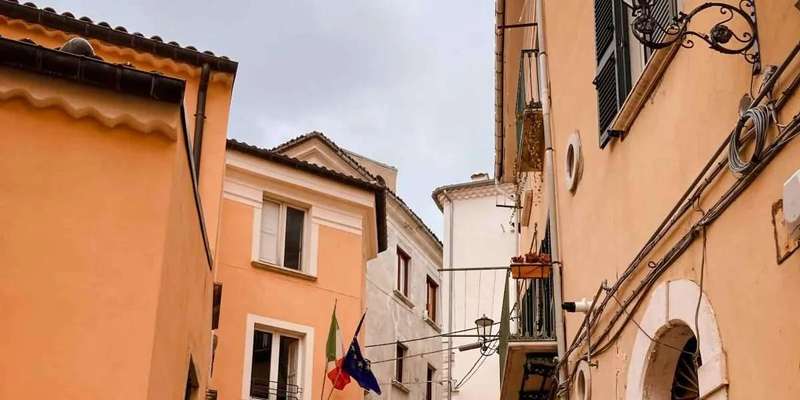- Home
- Useful Tips
- Walking routes through...
Navigating Campobasso's medieval heart presents a delightful challenge many travelers underestimate. The hilltop town's layered history reveals itself through steep staircases, sudden dead-ends, and unsigned pathways that leave visitors circling the same piazzas. Recent tourism board data shows 43% of day-trippers miss key landmarks like the Monforte Castle due to confusing signage, while others exhaust themselves on unnecessary climbs before reaching the vibrant artisan workshops. These maze-like streets weren't designed for modern navigation – their very charm lies in asymmetrical arches and hidden courtyards that foil digital maps. Without local knowledge, you risk missing the 15th-century frescoed chapel tucked behind a butcher's shop or the panoramic shortcut only widows use to reach the cathedral. The frustration isn't just about wasted time; it's the sinking realization you've walked past authentic trattorias with nonna-made cavatelli to settle for mediocre tourist menus near the bus station.


Decoding the elevation – smart routes to conquer Campobasso's hills
Campobasso's 700-meter altitude delivers breathtaking views but tests unprepared walkers. The secret lies in understanding the town's three-tiered layout: commercial streets at the base, civic buildings mid-slope, and the castle crowning the summit. Start at Piazza Municipio where a deceptively gentle ramp near the clock tower leads to Via Chiarizia. This 18th-century stairway – locals call it 'the donkey steps' for its manageable incline – winds past baroque balconies with regular landings for breath-catching. Those heading directly to the castle should veer right at the third landing onto Vico dei Mille, a cobbled backroute avoiding the steep final approach from Via Orefici. Morning walkers gain an advantage – sunlight illuminates subtle arrows carved into stone walls by 19th-century pilgrims, still visible beside house number 22 and near the abandoned leather workshop. Sturdy rubber-soled shoes prove essential; recent pavement restorations left some slopes treacherously smooth when wet.
Timing your stroll – when the streets come alive
Campobasso's rhythm dictates ideal walking hours most visitors miss. Dawn reveals the true medieval grid as delivery vans retreat by 7:30am, exposing original flagstones along Via Mazzini. Come late morning, follow grandmothers to the hidden produce market beneath San Leonardo church – their wicker baskets signal the most direct path downhill. Post-lunch hours (1:30-4pm) offer empty lanes perfect for photography, though many doorways remain shuttered until the evening passeggiata. This 6pm ritual transforms obscure alleys into social corridors; join locals promenading from Corso Vittorio Emanuele to Piazza Pepe for organic crowd-flow navigation. Wednesday and Saturday afternoons bring unexpected detours – antique dealers unfold stalls across Vico dei Sanniti, creating impromptu galleries that reroute foot traffic behind Palazzo San Giorgio. Smart walkers sync with these natural cycles rather than fighting them, turning potential frustrations into cultural immersion.
Landmarks as compass points – never losing your way
Campobasso's historic center rewards those who navigate by distinctive features rather than street names. The tilted bell tower of San Bartolomeo serves as a visual anchor visible from seven key intersections – when disoriented, locate its green copper dome. Three surviving medieval water fountains mark major route junctions: Fontana dei Bue near the museum district signals eastbound passages, while Fontana delle Conche indicates northward ascents. Clever walkers note ceramic house plaques depicting saints or animals; these 1700s address markers form memorable sequences (look for the owl-fish-lion progression guiding you to the Romanesque cloister). At confusing forks, choose the lane with uneven cobblestones – these often indicate original thoroughfares, while uniform paving marks later additions. Night walkers should identify bars with vintage neon signs; their glow highlights safe, well-trodden paths after dark.
Beyond the obvious – local-approved detours and resting spots
True Campobasso exploration means veering off the cathedral-castle-café triangle. Behind the unassuming door at Salita San Bartolomeo 14 lies a communal courtyard with 16th-century well – residents welcome respectful visitors to rest on its marble rim. The steep Vico Freddo lives up to its name ('cold alley') with natural air conditioning perfect for summer breaks, while ceramicist Marco Di Lallo's open workshop at Vico II Gradoni 7 offers shaded benches in exchange for admiring his traditional pignate pots. For strategic vistas, take the narrow passage beside Antico Caffè San Carlo leading to a hanging garden with valley views – the owner tolerates quiet guests who buy his almond torrone. These unofficial oases provide recovery moments while revealing the town's layered social fabric. Should knees demand mercy, the #3 minibus circling the centro storico accepts contactless payments, with drivers accustomed to flagging down red-faced walkers at non-marked stops.
